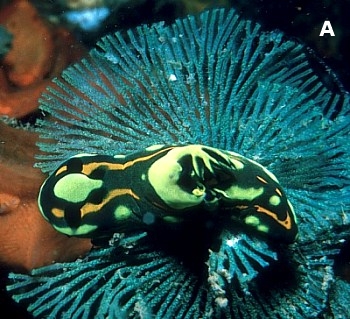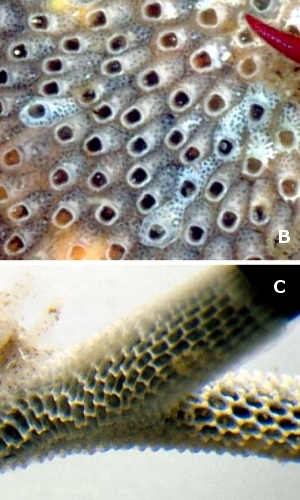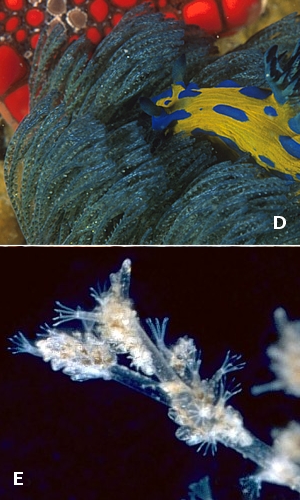
Bryozoa (Ectoprocta, Lace corals)
Phylum: BRYOZOA
PHOTO
A, unidentified. Photo: Scott Johnson [message #5325].B, Cryptosula pallasiana Photo: Bill Rudman [message #185 ].C, Membranipora membranacea Photo: Brian Darvell [message #6008 ].D, Bugula dentata Photo: Stuart Hutchison [message #6277].E, Zoobotryon verticillatum Photo: Bill Rudman [message #12656].
.
Most people are unaware of the Bryozoa, but the species that make up this family, are relatively numerous, with over 5000 described species and often abundant. Some species are economically important, as prominent fouling organisms quickly settling and growing on the hulls of ships, wharfs and wharf piles, while others can quickly grow and block industrial water intake and outflow pipes. The reason for their relative anonymity is that they live as colonies which have no standard shape, and are often mistaken for corals, sponges, hydroids and even marine plants.
Each individual or zooid lives in its own ‘house’ or zooecium, and from a single individual, many identical animals are budded off to form large colonies. Each zooid has a ring of feeding tentacles which surround the mouth, but the anus opens outside the tentacles which gives rise to the other name for this phylum – the Ectoprocta [= anus outside]. (See also Kamptozoa [Entoprocta]).
Illustrated here are some of the many different colony shapes and structures. Some form rigid calcified structures [Photo B,C ] which form layers over shells, rocks and algae, and are often called lace corals, while others have more flexible skeletons and form branched and bushy shapes [Photo A, D], often mistaken for algae. In Photo E, the extended feeding tentacles of a particularly gelatinous form, Zoobotryon, can be seen.
This page is a brief introduction to these animals which are the favoured food of many different groups of dorid nudibranchs. A quick search in the Forum for bryozoan will fnd many examples of nudibranchs which feed on one or a few particular species of bryozoan. For further information on Bryozoa have a look at the following two websites:
The Bryozoa Home Page
International Bryozoology Association web site


Rudman, W.B., 2006 (December 23) Bryozoa (Ectoprocta, Lace corals). [In] Sea Slug Forum. Australian Museum, Sydney. Available from http://www.seaslugforum.net/factsheet/bryozoa
